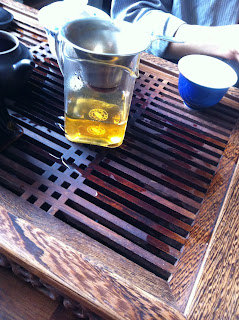Most definitely my style of drinking tea has changed with the move to Saskatchewan. I wake early and drink simple tea from a beautiful buncheong five person tea set by Korean ceramic master Kim Jong Pil, then at the office I drink tea from a ceramic one cup pu-gak style tea maker by ceramic master Huh Sang Wok while enjoying the view from the window, then a few times a week I travel two blocks down the road to Life with Tea & Art Ltd. to drink from a full Chinese Tea set up on a wood table with yi xing pots and porcelain cups. These last two samples from the China Chadao Event were sampled with tea shop owner Bill Hanbiao Ye. They were done over conversation and very informally. The following notes reflect both my and Bills opinions of the samples...
The Zeta was the only sample that I didn't get to try before reading Hobbes posting. In the posting Hobbes explained that it is a 2011 Douji "Pashi" Special Maocha.
The very long dry leaves contain lots of vibrant sweet smells in the mix of many light hairy mao cha. They smell of deep perfumery sweetness balanced with a slight light sugary pungent edge.
The first infusion delivers very light, sweet taste, very pure tastes. There is lots of odour in the cup with florals and full sweetness taking charge.
The second infusion was left for a good minute (oops) over lively conversation. The result is full of deep tastes of malty depth as well as sugar cane and wild flower high notes. A cool sensation is left in the mid-throat as it opens gentley. A malty-sweet sugar cane taste is left in the mouth. This long infusion delivers a nice balance of depth and sweetness.
The third infusion is another long steeping (double oops) once again caught up in good conversation! Again this pot displays a nice balance of deep bitter-sweetness and mainly sugar cane high notes. The qi of this tea is very calming on the mind- it has a profound impact on ones perspective.
The fourth infusion is much the same as the third but deeper notes are now exploited even more. The throatfeel reaches a deeper level in this infusion. The mouthfeel is fine but full.
The fifth infusion shows fatigue from the longer steeps at the beginning of the session. It stars loosing its kick but still has a very nice throat feel. There is a barely melon sweetness linger in the mouth.
The sixth and seventh infusion are much the same, watery now. The qi from this session is very mellowing.
The next tea sampled the following day was coded "Eta". This tea was also steeped up in the teahouse.
The dry leaves contain only a weak, distant odour. The faint smell is almost mushroom with a faint ambiguous sweetness that is hard to grasp in this mix of a few longish hairy leaves mixed with dark browny-greens.
The first infusion is very rich, velvety, and buttery. This creamy initial taste is somewhat expansive in the mouth and throat- finishing cool in the throat. There is a butterscotch aftertaste on the breath. This first infusion has only a bit of depth- mainly just smooth tastes.
The second infusion gives us a strong bitter-creamy initial taste with a slight rough mouthfeel. The creamier, malty tastes are drowned out by the bitter heavy edge.
The third infusion is much the same with bitter tastes becoming even stronger now. A single malty sweet taste underneath emerges more in the aftertaste.
We steep this tea for a few more infusions and conclude that this tea is likely of single mountain origin because of its monotone taste. We surmise it is likely around 2010.








No comments:
Post a Comment